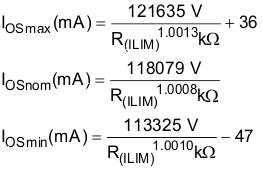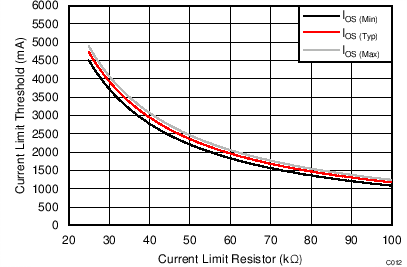SLVSCL5A June 2014 – November 2020 TPS2559
PRODUCTION DATA
- 1 Features
- 2 Applications
- 3 Description
- 4 Revision History
- 5 Device Comparison Table
- 6 Pin Configuration and Functions
- 7 Specifications
- 8 Detailed Description
-
9 Application and Implementation
- 9.1 Application Information
- 9.2
Typical Application
- 9.2.1 Design Requirements
- 9.2.2
Detailed Design Procedure
- 9.2.2.1 Step-by-Step Design Procedure
- 9.2.2.2 Input and Output Capacitance
- 9.2.2.3 Programming the Current-Limit Threshold
- 9.2.2.4 Design Above a Minimum Current Limit
- 9.2.2.5 Design Below a Maximum Current Limit
- 9.2.2.6 Accounting for Resistor Tolerance
- 9.2.2.7 Power Dissipation and Junction Temperature
- 9.2.2.8 Auto-Retry
- 9.2.2.9 Two-Level Current-Limit
- 9.2.3 Application Curves
- 10Power Supply Recommendations
- 11Layout
- 12Device and Documentation Support
- 13Mechanical, Packaging, and Orderable Information
Package Options
Mechanical Data (Package|Pins)
- DRC|10
Thermal pad, mechanical data (Package|Pins)
- DRC|10
Orderable Information
9.2.2.3 Programming the Current-Limit Threshold
The overcurrent threshold is user programmable via an external resistor. The TPS2559 uses an internal regulation loop to provide a regulated voltage on the ILIM pin. The current-limit threshold is proportional to the current sourced out of ILIM. The recommended 1% resistor range for R(ILIM) is 24.9 kΩ ≤ R(ILIM) ≤ 100 kΩ to ensure stability of the internal regulation loop.
When ILIM pin short to GND (single point failure), maximum current limit is less than 8 A over temperature and process variation.
Many applications require that the minimum current limit is above a certain current level or that the maximum current limit is below a certain current level, so it is important to consider the tolerance of the overcurrent threshold when selecting a value for R(ILIM). The equations and the graph below can be used to estimate the minimum and maximum variation of the current-limit threshold for a predefined resistor value within R(ILIM) is 24.9 kΩ ≤ R(ILIM) ≤ 100 kΩ. This variation is an approximation only and does not take into account, for example, the resistor tolerance. For examples of more-precise variation of IOS refer to the current-limit section of the Section 7.5 table.

24.9 kΩ ≤ R(ILIM) ≤ 100 kΩ
 Figure 9-2 Current-Limit vs R(ILIM)
Figure 9-2 Current-Limit vs R(ILIM)